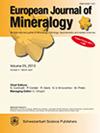Petrological study of an eclogite-facies metagranite from the Champtoceaux Complex (La Picherais, Armorican Massif, France)
IF 1.7
3区 地球科学
Q2 MINERALOGY
引用次数: 1
Abstract
Abstract. The high-pressure metagranite of La Picherais belongs to the Cellier Unit (part of the lower allochthon of the Champtoceaux Complex; Armorican Massif, western France), where it crops out as an undeformed body embedded within the orthogneisses of the Cellier Unit and is closely associated with numerous mafic eclogite lenses and seldom metahornfels. The petrographic observations of this metagranite reveal the presence of well-developed reaction textures: (1) pseudomorph after plagioclase, (2) garnet and phengite coronae at biotite–plagioclase interfaces, (3) garnet and phengite coronae at biotite–K-feldspar interfaces, and (4) garnet and rutile coronae at ilmenite–plagioclase interfaces, attesting that it underwent high-pressure and low-temperature conditions after the granite intrusion and its cooling. The analysis of the coronae and of a xenolith inclusion found in this granite points to pressure (P) and temperature (T) estimates of P>1.7 GPa and T=600–650 ∘C for the peak of metamorphism. P–T estimates performed on the mafic eclogite collected in the vicinity of the metagranite give values of 2.0–2.2 GPa and 640–680 ∘C, in good agreement with previous estimates made in other places within the Cellier Unit. The La Picherais metagranite is a key example of undeformed high-pressure metagranite allowing the study of the reactivity and degree of transformation of quartzofeldspathic rocks during subduction and constitutes a Variscan equivalent of the Alpine Monte Mucrone or Brossasco–Isasca metagranitoids.法国armoramerican地块La Picherais Champtoceaux杂岩中榴辉岩相变长岩的岩石学研究
摘要La picherais高压辉长岩属于舍普托索杂岩下异体的Cellier单元;阿莫里亚地块(法国西部),在那里它是一个未变形的体,嵌入在地层统一体的正统性中,与许多镁质榴辉岩透镜和很少的异角岩密切相关。岩石学观察表明,该辉长岩具有发育良好的反应结构:(1)斜长石后的伪晶状,(2)黑云母-斜长石界面的石榴石和云母冕,(3)黑云母-钾长石界面的石榴石和云母冕,(4)钛铁矿-斜长石界面的石榴石和金红石冕,说明其在花岗岩侵入和冷却后经历了高压和低温条件。对在这块花岗岩中发现的日冕和包体的分析表明,其压力(P)和温度(T)的估计为pbbb1.7 GPa, T= 600-650°C是变质作用的顶峰。对在变长岩附近收集的基性榴辉岩所作的P-T估算值为2.0-2.2 GPa和640-680°C,与早先在Cellier部队其他地方所作的估算值非常吻合。La Picherais变质花岗岩是未变形的高压变质花岗岩的一个重要例子,它可以用来研究俯冲过程中石英场滑石岩的反应性和转化程度,它与阿尔卑斯蒙特马格罗内或布罗萨斯科-伊萨斯卡变质花岗岩在variscanan上的等效物。
本文章由计算机程序翻译,如有差异,请以英文原文为准。
求助全文
约1分钟内获得全文
求助全文
来源期刊
CiteScore
2.80
自引率
9.50%
发文量
40
审稿时长
6-12 weeks
期刊介绍:
EJM was founded to reach a large audience on an international scale and also for achieving closer cooperation of European countries in the publication of scientific results. The founding societies have set themselves the task of publishing a journal of the highest standard open to all scientists performing mineralogical research in the widest sense of the term, all over the world. Contributions will therefore be published primarily in English.
EJM publishes original papers, review articles and letters dealing with the mineralogical sciences s.l., primarily mineralogy, petrology, geochemistry, crystallography and ore deposits, but also biomineralogy, environmental, applied and technical mineralogy. Nevertheless, papers in any related field, including cultural heritage, will be considered.

 求助内容:
求助内容: 应助结果提醒方式:
应助结果提醒方式:


